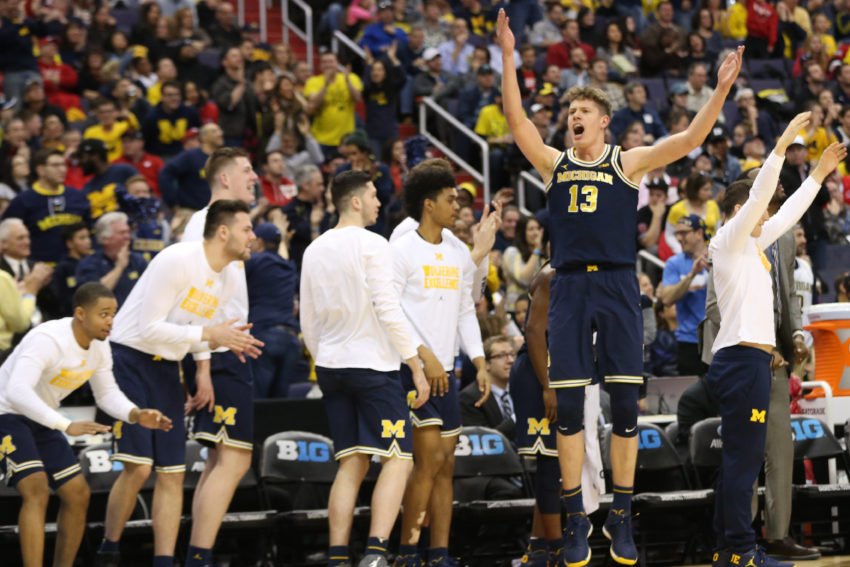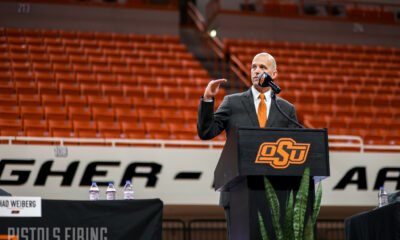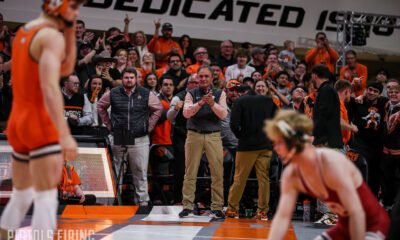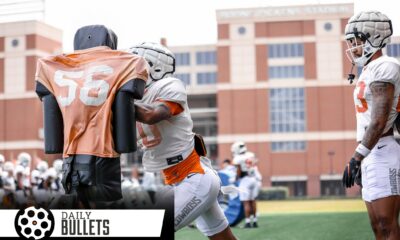Hoops
Similarities and Differences between Oklahoma State and Michigan

When the Oklahoma State Cowboys step onto the floor in Indianapolis on Friday morning to play the Michigan Wolverines, they see a team outside of the rugged Big 12 for the first time since running Arkansas all the way out of GIA back at the end of January. John Beilein and his Big 10 tournament winning squad are on a roll, winning 10 of their last 12 games and roaring into the field as an underseeded 7 seed.
Michigan is an interesting team of extremes- in some ways, they very similar to our own Cowboys squad, and in other ways they are incredibly different. Let’s take a look at three ways the Wolverines and the Pokes are alike, and three ways the two couldn’t be more different.
Similarity 1: Both Teams Are money at the charity stripe
We’ve discussed it before on the blog, but this year’s Oklahoma State team is one of the premier free throw shooting teams in the nation, knocking down 78.7% of their FT’s, the 5th highest percentage in the country. This is a very good sign in a close game (especially in the NCAA tournament) and a significant advantage over almost any other team the Cowboys will play.
The only issue? Michigan is almost as good. This Wolverine team ranked 10th nationally with a 77.5% free throw percentage, only about a percentage point less than the Pokes. Lead by senior point guard Derrick Walton and his 87.2%, Michigan cashes in on the majority of its’ chances at the line, so it will be vital that the Cowboys avoid too much foul trouble against the Maize and Blue.
Similarity 2: Both teams are ruthlessly efficient on offense
Both Oklahoma State and Michigan rank in the top 10 nationally in offensive efficiency (Oklahoma State is 1st and Michigan is 6th). Oklahoma State leads the nation with a stunning 124.5 points per 100 possessions, and Michigan is not far behind with a 121.7 points per 100 possessions, despite getting there a very different way from OSU (more on this in a minute).
Michigan runs with four upperclassmen in the starting line-up (2 seniors, 2 juniors, and a sophomore) and feature incredible balance, with all five starters averaging over 9 points per game and three over 12 points per game (senior guard Zak Irvin, senior guard Derrick Walton, and sophomore forward Morritz Wagner). Oklahoma State also boasts a strong backcourt, with guards Jawun Evans and Phil Forte averaging in double figures, as well as swingman Jeffrey Carroll.
Similarity 3: A lights out floor general runs the show
Point guards typically own March, and this opening round matchup will boast two of the very best point guards in the field in Oklahoma State’s Jawun Evans and Michigan’s Derrick Walton. Walton, an All Big-10 Second-Teamer, averaged a cool 15.2 points per game, 4.7 rebounds per game, and 4.7 assists per game, while shooting 41.2% from 3 and 87.2% from the free throw line. Dude’s a stud.
Derrick Walton Jr. Yacking on Minnesota ? pic.twitter.com/bN5eTN5pbk
— Abdul Memon (@abdulamemon) March 11, 2017
The Cowboys counter with All Big-12 First Teamer Jawun Evans, with his even gaudier 19 points per game, 3.3 rebounds per game, and 6.2 assists per game. Evans is the engine that makes the Cowboys go, and if they are able to make any noise in this tournament, it’s because no. 1 balled out. You think he’s ready to go?
Jawun Evans cringed as Seth Davis hyped Lville-Michigan matchup on CBS. Evans told me: “Yeah, I heard that. I’m gonna keep that in mind.”
— Guerin Emig (@GuerinEmig) March 12, 2017
So both teams are incredible free throw shooting teams, make the most of their offensive possessions, and are lead by a stud at the point. How are these teams different?
Difference 1: Tempo
Remember how I said Michigan gets to their impressive offensive efficiency ranking (6th nationally) in a very different way than Oklahoma State? The Wolverines are slow and methodical in their offense (insert Big 10 joke), with an average possession length of 19.6 seconds per possession.
Coach Beilein has instructed his team to play in the half court, run work the ball around for an open shot, and run one of the most efficient offenses in the college game. With four starters averaging in double figures and the fifth averaging 9 points per game, Oklahoma State will have its’ hands full trying to slow Michigan down.
On the flip side, Oklahoma State plays quicker, with an average possession length of 16.5 seconds per possession. The Cowboys are incredibly effective with speedy point guards Jawun Evans and Brandon Averette pushing the ball, which creates fastbreak opportunities for outstanding finishers like Jeffrey Carroll and Davon Dillard, as well as open threes for sharpshooters like Carroll, Phil Forte, and more.
Jawun Evans, coast to coast. pic.twitter.com/VrZSy7DIaY
— Pistols Firing (@pistolsguy) January 31, 2017
Difference 2: Turnovers
This stat goes hand in hand with the above tempo numbers- Michigan is stingy with the ball, only turning it over on 14.6% of its’ possessions. The Wolverines like to work the clock, get all five players on the court involved in the offense, and stay patient until a good shot opens up.
The Cowboys on the other hand shot for volume- Brad Underwood’s philosophy of simply putting up more shots than the opponent is largely effective (see no. 1 ranked offense in the country) but can lead to some turnovers- the Cowboys turn it over on 18.3% of their possessions, ranking 153rd in the country. The Cowboys can take Michigan out of their game by pushing the tempo, but need to be smart and avoid sloppiness with the ball in the process.
Difference 3: Reliance On Bench Minutes
It shouldn’t be a surprise that with a slower tempo, this Michigan squad only has seven players that play double digit minutes per game, including four players that average over 30 minutes a game. The Big 10 was full of teams that love to slow the tempo, run offense, rebound, and keep the score low.
Enter the high-flying Oklahoma State Cowboys, the second highest scoring team in the history of the Big 12, who play nine guys that average double digit minutes, and just one player (Jawun Evans) that plays more than 30 minutes a game. Brad Underwood’s Cowboys will look to play an uptempo track meet against the Wolverines and run them right out of Indianpolis.
Here’s an interesting number: Oklahoma State, after a brutal (and incredibly impressive) run through the Big 12, have played just 3 games in the last 13 days, with a long rest before the NCAA tournament begins. Contrast that with Michigan, who is heavily reliant on four starters playing at least 30 minutes a game, who’s played twice as many games (6 games) in that same stretch, including four in four days last week.
Sure, the Wolverines looked impressive and deserve a lot of praise after their Big 10 Tournament run, especially after surviving a harrowing experience on their botched flight. But the legs of those starters may not have much mileage left on them, and the Cowboys come in with some time to rest up. It should be a high-scoring, entertaining tilt in Indianapolis as the Cowboys try to win their first NCAA tournament game since 2009.

-

 Hoops5 days ago
Hoops5 days agoTwo Transfer Portal Prospects Put Oklahoma State in Top Group
-

 Wrestling4 days ago
Wrestling4 days agoOSU Wrestling: John Smith Announces Retirement
-

 Hoops4 days ago
Hoops4 days agoFormer Western Kentucky Assistant Robert Guster Follows Lutz to Stillwater
-

 Daily Bullets5 days ago
Daily Bullets5 days agoDaily Bullets (Apr. 11): Pokes Land a Couple of Commits, Add Another Coach (Sort Of)






